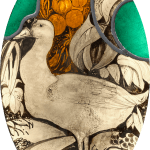Willem van den Berg (1886-1970)
Further images
Willem van den Berg was born on February 16, 1886 in The Hague, where he first trained with his father, Andries van den Berg, a painter, print-maker and art teacher. He later enrolled at the local Academie voor Beeldende Kunst and befriended the artist Willem van Konijnenburg (1868-1943) in 1913. Van den Berg also took study trips to Belgium, Italy and England and worked with the Barbizon artists in France and exhibited at the Jeu de Paume in Paris in 1926. In 1935, Van den Berg exhibited at the Art Institute of Chicago, and continued to paint and exhibit internationally throughout his career. By 1938 he moved to Amsterdam, where he became the director of the National Academy of Fine Arts and remained there until his death on 23 December 1970.
Like his contemporaries, Van den Berg found inspiration in the nineteenth century Amsterdam zoo Artis, sketching animals to be worked on in the studio in a variety of mediums such as lithographs, woodcuts, drawings or paintings. Funny creatures captured Van den Berg’s imagination as the many iterations of large feathered birds indicate. The present stained glass windows of ducks—not necessarily zoo residents—are a rare medium in the artist’s artistic output. Difficult to date, perhaps fellow Dutch Art Nouveau artist Johan Thorn Prikker (1868-1932) completed windows for the Romanesque Church of Saint George in Cologne in 1930 were an inspiration. Van den Berg’s graphic eloquence and vibrant smoldering colors with the effect of the lead lines produce a contemporary twist on the medieval window genre.





